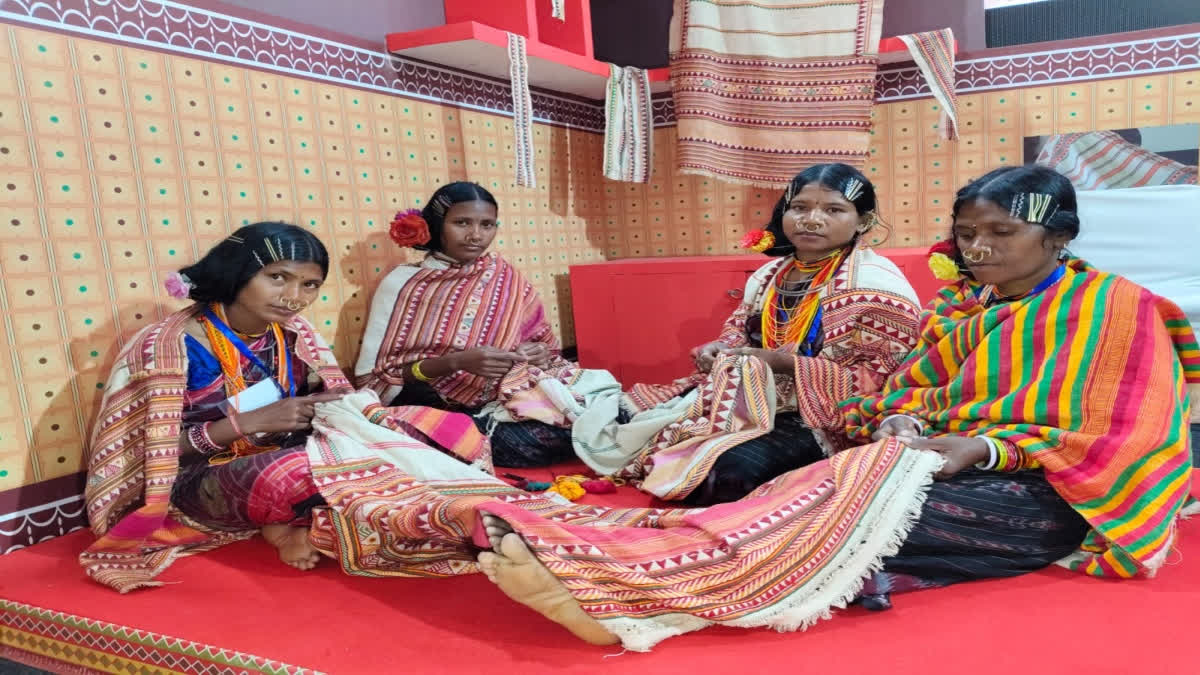Bhubaneswar: If beauty lies in the eyes of the beholder, the hordes of delegates at the Janata Maidan, had an eyeful. Different and unique - the Kapdaganda shawls and their creators - were naturally the cynosure of all eyes at the Pravasi Bharatiya Divas. Matching with the vibrant hues of Kapdaganda, an important cultural object for the Dongria Kondhs, were four tribal women who, with hair oiled and cleanly tied in metallic clips, flowers tucked from behind the multiple-pierced ear, nose rings and beaded ornaments flowing thickly from the neck, and wrapped in shawls - were busy weaving with ease. They had come all the way from Niyamgiri hills in Rayagada district to present their craft in front of the diaspora at a time when the fabric is struggling for existence.
Kapdaganda is an embroidered shawl or a scarf made up of hand-made threads , and considered a cultural tag of the people belonging to Niyamgiri area. Currently, the fabric and the creators are struggling for survival. However, the Pravasi Bharatiya Divas offered them an opportunity to showcase it, and got the much-needed appreciation from the NRIs, igniting hope of revival.
Of the four craftswomen, Chuki Wardaka is lucky, for, she has been invited by some guests to participate in the exhibition scheduled in the US sometime this year. About 20 years old, Chuki from Khajuri village is a matriculate from Chartikona School. Though she followed in her brother's footsteps to study well, she could not pursue higher education after her father and brother's demise. Since there was none to look after farms, Chuki shouldered the responsibility along with her mother. But as is the tradition, most Dongrias learn weaving Kapdaganda and Chuki was learning the ropes from her mother alongside farming.
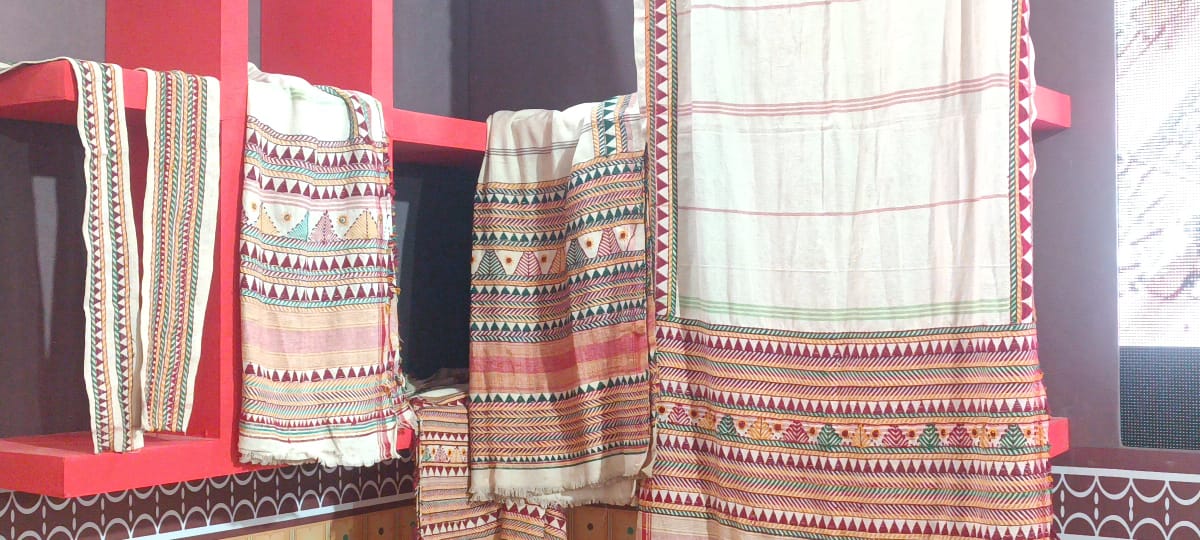
"I learnt the tricks of the trade from my mother and grand mother and now am able to complete a shawl all by myself," says a shy Chuki.
Among the other three, Kumradi Pusika, about 35 years old, is a mother of four children. Married when a minor, Kumradi's husband deserted her and remarried another woman. Without any option, Kumradi started staying with her father and weaves Kapdaganda along with her brother to add to the family income. But it hardly suffices, given the challenges of procuring raw materials. Pulma Wardaka, another tribal woman, was separated from her parents since she was a child. After her elder sister got married, 25-year-old Pulma is forced to live with her relatives where she too weaves the shawl. Minjili Wardaka, is too young to work, but as in every tribal family, they pass on the heritage to the children and so Minjili also indulges in weaving when she is not in school.
To bail out Chuki, Kumradi, Pulma, and Minjili and the likes from struggling with the hand weaving work, Dangaria Kandha Development Agency (DKDA), Odisha Rural Development and Marketing Agency (ORMAS) and Tribal Development Co-operative Corporation of Odisha Ltd (TDCC) have been making efforts. The responsibility of training, providing raw materials, and its marketing have been taken up by these three agencies.
Chuki Wardaka says, "I have been trained by the DKDA and learnt some skills but marketing continues to be a challenge. We cannot sustain with whatever we earn through weaving."
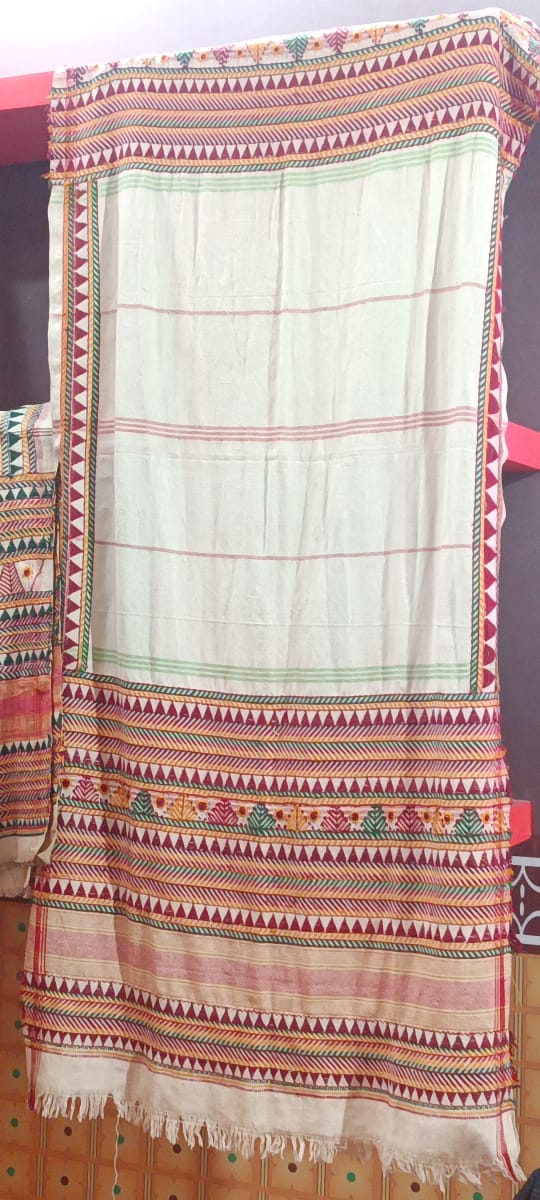
She has also received training to work with sewing machines and had been sent to Tamil Nadu for furthering her skills. "We face problems of procuring the thread and fabric needed for making products. Now the DKDA is providing us with cotton. From that it takes us a month or two to weave thread balls and then make it into fabric. But despite odds I would want to continue the legacy and take our heritage around the world," said a visibly buoyed Chuki, after garnering appreciation from the visitors.
The Kapdaganda shawl or scarf holds a lot of meaning for the tribals, especially the Dongrias. It is a symbol of love for the Dhangada Dhangadi as the young boys and girls of the tribe are addressed. In the earlier days, it was only the unmarried girls who used to weave the fabric. When a girl presents her woven scarf to a boy, he becomes her life partner. But with time, legacy is giving way to modernity. Both men and women wear the shawl and scarf on the occasion of weddings or ceremonial observations. The base color of the fabric often remains off white and a varied range of coloured threads are used to add dimension through embroidery.
The use of natural colors is typical to the fabric. For the color to last, various types of spices are used along with turmeric, juice of bay leaves, jhampara seeds, tangi flowers and other natural ingredients. They dye the yarns only in green, red, yellow and earthy colours. "Earlier, yarn was easily available from the nearby market to make shawls. But due to its unavailability, we have to depend on other regions. The handmade cloth of Dongrias is now found only in Jhigidi village in Bismaktak block," says Pulma.
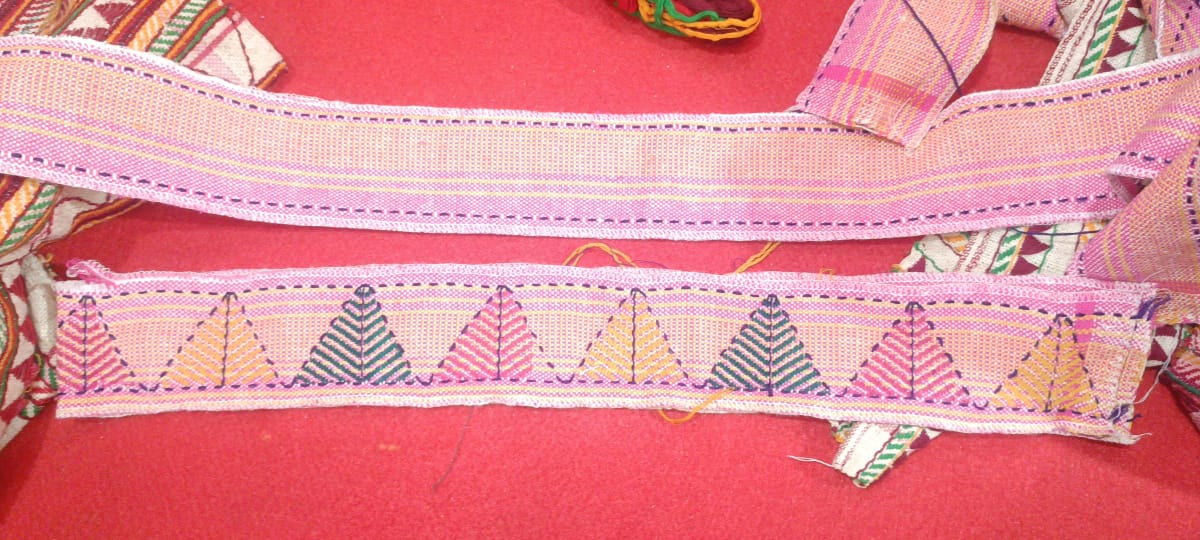
Guha Punam Tapas Kumar, Odisha’s Secretary of Handlooms and Handicrafts, says, “We’ve been working for years to secure the GI tag and improve the craft’s visibility. The demand for these shawls is growing in both national and international markets. With proper training and marketing, we can ensure the sustainability of this heritage.”
Though the demand for the Kapdaganda fabric is on the rise, lack of enough raw materials, promotion and market linkage are affecting the weavers. "Efforts have started to revive it while still in use. The government has also stepped in, securing a GI tag in last January for Dongria weave, which has boosted its status," says the secretary.
Researcher Surya Narayan Padhi explains that the Dongria Kondhs are primitive people living in the Niyamgiri hills. Unless their weaving talent is honed and they are given exposure, the craft will die, asserts, adding, "They have prepared masks, belts, Uttariyas and small currency pouches. Some of their products are also being bought by the visitors here. Once the youngsters are trained, they can weave faster and earn more money."
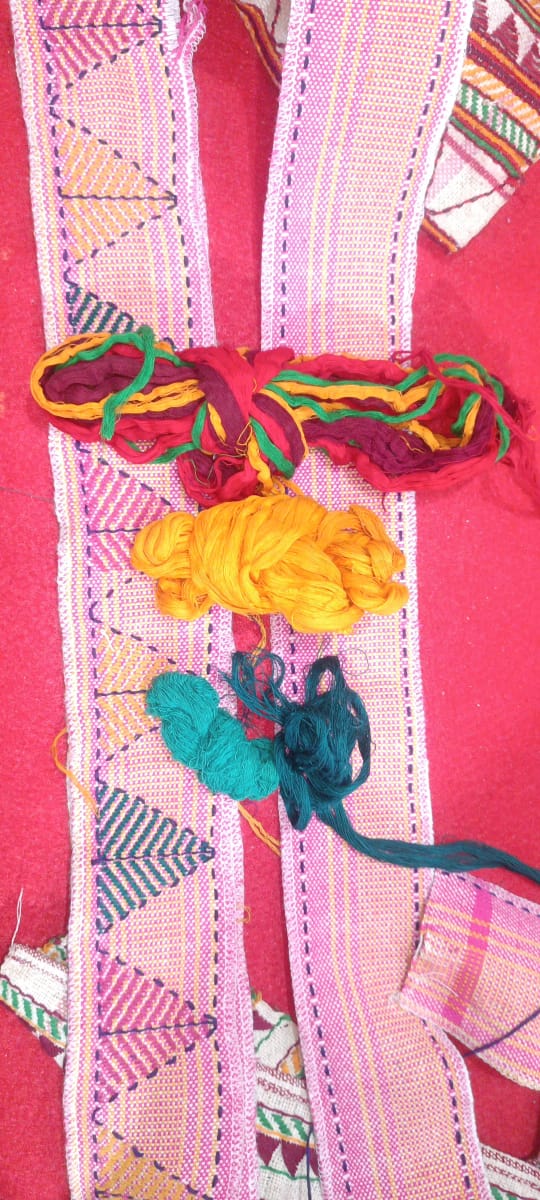
He also says that the problem of collecting and supplying the raw materials is paramount to keep the craft alive and sustaining. "From the making of the thread to the shawl, everything is done with hands. It takes 3 to 4 months to weave a single cloth. Its quite a task on the eyes and the back, particularly because this is not their mainstay. They also cultivate their farmlands and then weave in their free time," he says. For one piece of cloth, the Dongria's earn Rs 2000 while the materials are provided by the government.
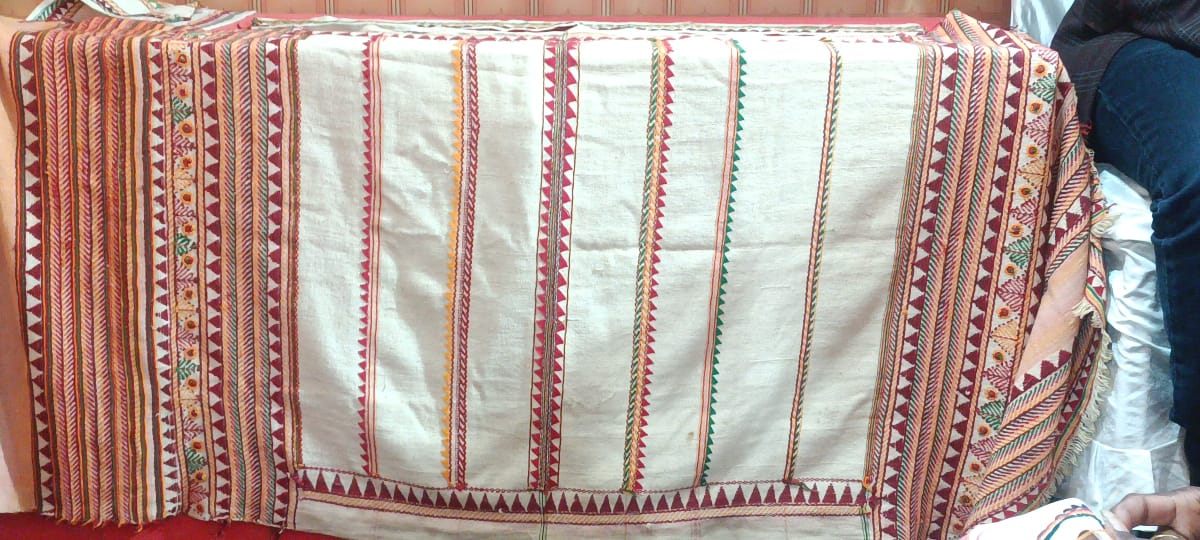
Since the fabric is in demand in national and international markets, we are making arrangements to train them and take them on exposure visits to different states and countries. Some have become self-reliant by making these shawls but a lot more can be done as the demand for the product is growing, he further states.
"Now we are working to improve the fabric which is very difficult because it is unique. We also have a major responsibility for marketing the cloth. Six years ago, a piece of Kapdaganda cloth was sold for Rs 600 in Odisha while, in New Delhi, it was selling at Rs 2000 to Rs 3000. Now the price has increased further. Therefore, various types of training are being imparted to the Dongrias to preserve their artistic tradition and also enlarge the market space for them to earn a decent livelihood," explains Guha Punam Tapas Kumar.
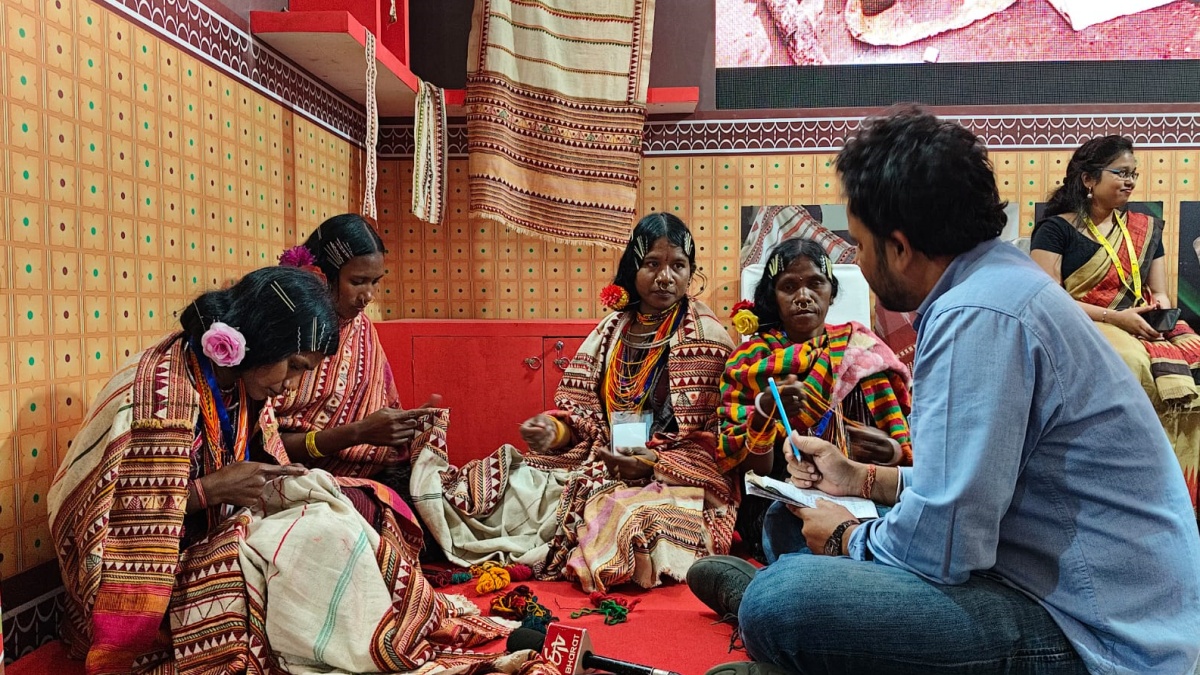
All said, Chuki remains optimistic even in the face of adverse circumstances. "We all like weaving the fabric, but were a little doubtful. Whenever we are taken to places where our product is loved, we gain back our confidence to weave more and more," says an enthusiastic Chuki.
